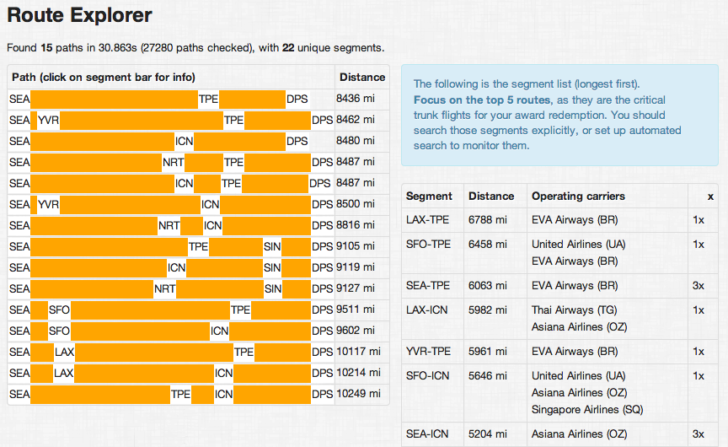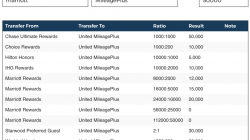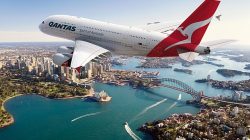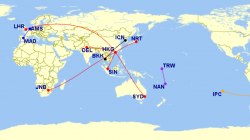My guess is 99% of people plan their trip by doing a search from A to B. Not me. I like to know my options before I run my search so I can exclude bad connections or force especially good ones. Relying on a dumb computer to tell you how to get to your destination can overlook a lot of good alternatives, both for booking revenue flights and award flights.
Consider a hypothetical trip from Seattle to Bali. If you were to use United Airlines miles, you won’t find any award space on Singapore Airlines by searching on United.com. United just doesn’t show Singapore in their online system, though you can find it if you call in or search on a different Star Alliance parter (e.g., ANA). The same goes for booking Alaska Airlines with Avios points. British Airways won’t search for Alaska online, but their agents can find it just fine, so you need to know to search on American or Alaska’s site first. Some pointers:
- To search for Alaska Airlines award space: American or Alaska’s websites
(Alaska may list two prices in the column for saver award fares, but only the cheaper of the two is valid when using partners’ miles) - To search for oneworld award space: Qantas or British Airways’ websites
(both suck IMO) - To search for Star Alliance award space: United, ANA, or Aeroplan’s websites
(United is easy to use, but has some glaring omissions) - To search for SkyTeam award space: Delta or Flying Blue’s websites
(Delta doesn’t always let its members book the award space its partners offer to each other)
Why does this matter as long as you get to your destination? Because the routes you can find online if you look in the wrong places might suck. United will try to route you to Bali via Bangkok, which I find rather drab compared to the SilverKris lounge in Singapore — not to mention it’s easier to head into town on a short connection. Alaska has tons of nonstop flights to Hawaii and throughout the West Coast, while flying on American might require a connection (and more Avios).
Know the Hubs
Most airlines use a hub-and-spoke system. Even Southwest Airlines runs a large amount of its traffic through key cities like Las Vegas and Denver. So know the hubs in order to plan the most effective way to get from your home to your destination. Even if you don’t live at a hub, you may live close enough to one that there are many flights each day such that adding a connection won’t be a problem.
I live in Seattle, but I consider Vancouver, Portland, San Francisco, and Los Angeles to be valid alternatives to originate a long trip. In some cases, I’ll also look at Oakland, San Jose, Denver, and San Diego.
Knowing where two carriers’ hubs overlap can also help when it is prohibitive to use a single carrier for the entire journey, either due to cost or scheduling. When my in-laws were flying back from Maui, I booked them non-stop on United Airlines to Denver, but I couldn’t find them award flights to Amarillo. Fortunately Southwest also has a large presence in Denver, and I could book them a backup. Flying from one carrier’s hub to the hub of a competitor (e.g., Houston to Miami) can also be surprisingly affordable if there’s a fare war in progress.
Explore the Details
I talked last week about different tools that will tell you who flies which routes. If you are visiting particularly obscure places — or even if you are running out of options on popular routes — this can be helpful. You may not know that a particular carrier flies to your destination. If they only sell tickets through their own website instead of a GDS, now you know where to look when previous searches turned up dry.
Go Big or Go Home
The most important part of any trip is going to be the long-haul route. It isn’t especially hard to book an award from Seattle to San Francisco to Dallas to JFK to London. It’s much more difficult to book Seattle to London non-stop. Or even Seattle to San Francisco to London. This is because (1) most people hate connections and are also booking non-stop and (2) long-haul flights tend to be lower frequencies.
So identify all your options from the start. You’ll want to focus on the overwater routes for most international journeys, and you can get a good idea of what’s available by using a search tool like OpenFlights or reading one of several posts by the Wandering Aramean. Here are some examples:
- Collection of oneworld Alliance Trans-Atlantic Routes
- Collection of Star Alliance Trans-Atlantic Routes
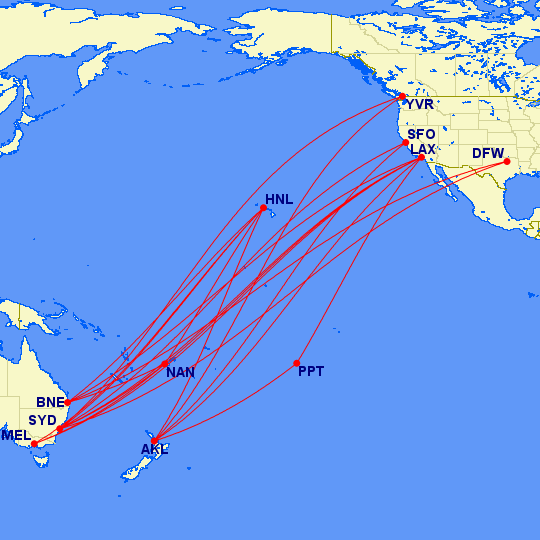
I personally pull out a pen and paper so I can draw all of the possible routes. As I notice my pen passing through the same cities over and over I will focus on those when I do my search. For example, JFK to London might be in five of 15 possible itineraries, so I will really want to find a flight on that route to open up other options. It’s not ideal, but it could make other things easier. I can then focus on SFO to London. If I’m booking an award ticket, I might even lock down JFK to London immediately and then change the reservation later as I find better options.
One benefit to my approach is that I can write down flight numbers and prices or cabin availability next to each route. Then I can look at which itinerary offers the best bang for my buck.
Award Nexus is one tool I recommend for help doing these tasks for you. They have a Route Explorer that will search for and tell you all your options for getting from A to B (this is intended mostly for international awards, not revenue or domestic flights). You can even choose your direction of travel or exclude certain airports. In this results page, you can see which routes are served by the most carriers and which show up most frequently in all possible routings.
Get Unconventional
If you are still having trouble — or if you just want to have some fun — start thinking about interesting ways to turn your trip on its head.
You DO NOT need to fly from your home airport to your destination airport. This is especially important if you’re considering an award with American Airlines, since the overwater carrier must have a published fare between the origin and destination. You may need to get yourself to a different city to being or end your trip.
No reasonable trans-Pacific flights available to Japan? Look into whether your carrier permits awards via Europe. It may take about the same time if you are starting from the East Coast. (But here in Seattle, Megan always glares at me when I make the suggestion.)
If you’re visiting more than one city, look into the stopover and open jaw rules for your revenue or award ticket. United let me book an open jaw with a stopover on our honeymoon trip to Southeast Asia for the same price as a simple round trip. That meant I could fly to Bali (stopover), begin the trip home to Bangkok (destination), and return home from Hong Kong (the open jaw, since it’s not the same city as my destination).
Book a ticket to a smaller city like Brussels or Zurich and then take the train to your final destination. It’s more scenic and possibly the same investment (in dollars and time) when compared to connecting in an airport.
Use hidden city ticketing. Flights from Seattle to Reno that connect in San Francisco may be cheaper than those that only go from Seattle to San Francisco. Why? Fares are based on supply and demand, and there may be more demand to go to San Francisco even though all passengers to Reno still have to connect. As long as you don’t have checked baggage and can risk being rebooked on a non-stop flight (due to weather or other irregular operations), then consider booking the longer itinerary and throwing away the last segment.
Be Flexible and Reasonable
Above all else, know your limits. If you want to fly to Australia for Christmas with a family of six in first class, you aren’t going to go unless you mortgage your house. The award space just isn’t there. Most carriers make it hard enough to book awards for one or two people. The flexibility to split up a large group on different flights or in different cabins can help a lot, as can searching on different days. Award Nexus has a handy guide to long-haul award searches that you can access even if you aren’t a customer.
If you are planning to book revenue flights anyway, take a look at ITA Matrix. It will usually alert you when there aren’t enough seats in your booking class for the entire party. If, say, you need two tickets on United but there is only one seat in W and the second seat will be in V, it will show the average price with an asterisk next to it. You will probably need to book these tickets separately. If you were to go straight to the airline website, chances are you’d end up paying for both tickets at the higher V fare without knowing one was available as W.
As with most things, the more legwork you are willing to do on your own, the more sure you can be that you found the best price or routing. Sometimes you won’t save any money. At least you’ll know you couldn’t have done it any better.


